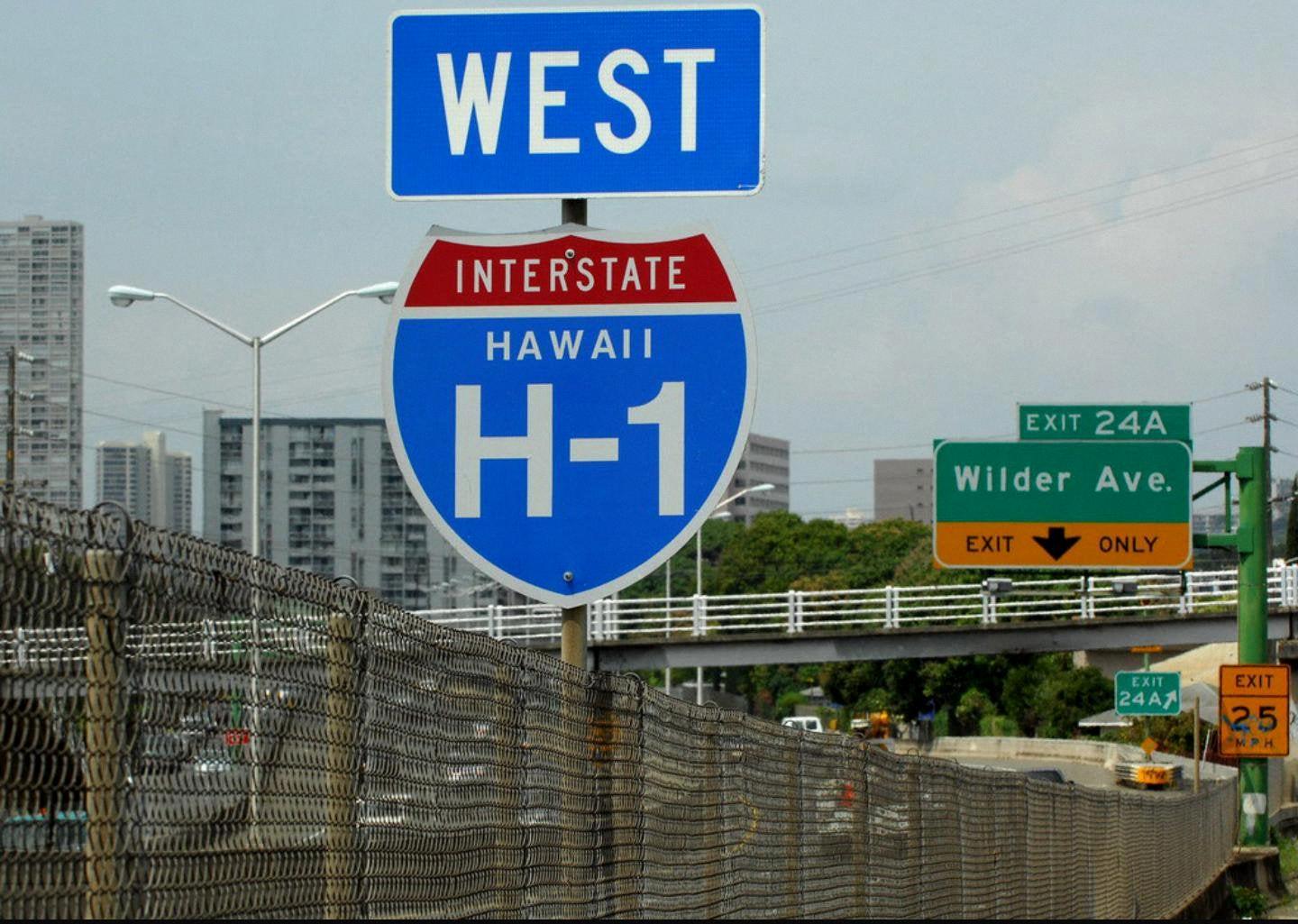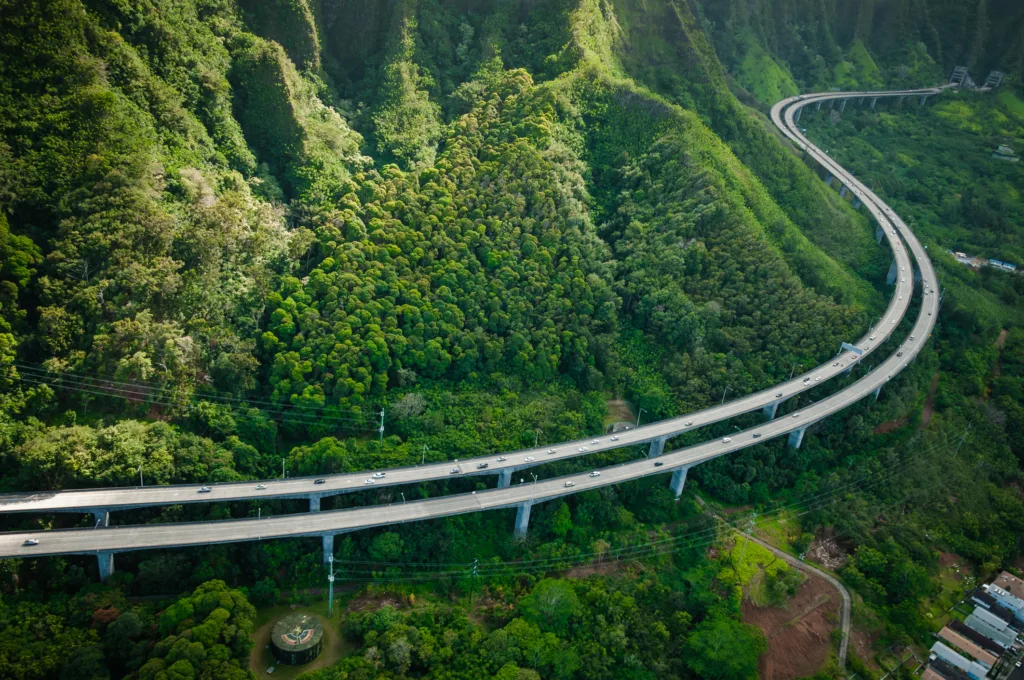Interstate highways in Hawaii are a unique and important part of the state’s transportation system. While they are not connected to the mainland United States’ Interstate system, they are built to the same high standards and provide crucial connections for residents and visitors alike.
The longest and busiest of these highways is Interstate H-1, which runs through the island of O’ahu. This highway, also known as the Lunalilo Freeway and Queen Liliuokalani Freeway, connects Honolulu with the western and southern parts of the island. It is a major transportation artery for both commuters and tourists, providing access to popular destinations like Pearl Harbor and Waikiki Beach.
In addition to H-1, there are several other Interstate highways on O’ahu. Interstate H-2, also known as the Veterans Memorial Freeway, runs north from H-1 and connects with the towns of Mililani and Wahiawa. This highway is an important link for residents of these areas, providing access to jobs and services in Honolulu.
Interstate H-3, named afer former Hawaii Governor John A. Burns, is a newer highway that runs from Kaneohe on the windward side of O’ahu to Halawa Valley on the island’s south shore. This highway is notable for its scenic views and engineering feats, including a series of tunnels and viaducts that cut through the Ko’olau Mountains.
There is Interstate H-201, also known as the Moanalua Freeway, which runs from Aiea to Honolulu International Airport. This highway provides an important connection for travelers, allowing them to bypass traffic in downtown Honolulu and reach the airport more quickly.
Hawaii’s Interstate highways are a vital part of the state’s transportation infrastructure. While they may not be connected to the mainland system, they provide crucial links for residents and visitors alike. Whether you’re commuting to work or exploring the island’s natural wonders, these highways offer a convenient and efficient way to get around.
The Absence of Interstates in Hawaii
Hawaii, despite being a part of the United States, does not have any Interstates connected to those in the continental United States. This is due to the fact that Hawaii is located in the middle of the Pacific Ocean, separated by thousands of miles of water from the mainland United States.
However, it is worth noting that Hawaii’s highways are built to the same standards as the Interstates found in the continental United States. The highways in Hawaii are designed to handle high volumes of traffic and are engineered for safety and efficiency.
These highways are designated with an “H” number, raher than an “I” number, which differentiates them from the connected system of Interstate routes on the mainland. This is essentially a naming convention and does not affect the quality or standards of the highways in Hawaii.
While Hawaii may not have any Interstates connected to those in the continental United States due to its geographical location, the state’s highways are built to the same standards and are designed for high volumes of traffic and safety.

Source: reddit.com
The Presence of Interstates in Hawaii
There is one interstate in Hawaii, which is Interstate H-1. It is the only interstate highway in the state and is located on the island of O’ahu. The highway stretches for 27.3 miles and is the longest and busiest in the state. It connects Honolulu to the western part of the island, passing through major cities such as Pearl City, Aiea, and Waipahu.
Interstate H-1 is a crucial transportation route for both residents and tourists, providing access to varios attractions, such as the Pearl Harbor National Memorial, the Ala Moana Center, and the Waikiki Beach. The highway is also important for commercial purposes, as it connects the Honolulu International Airport and the Honolulu Harbor to other parts of the island.
The construction of Interstate H-1 began in the 1950s and was completed in the 1960s. It was initially designed to accommodate the increasing number of cars on the island, which were causing traffic congestion on the existing roads. Today, the highway is a vital part of Hawaii’s transportation infrastructure, serving thousands of drivers daily.
While Hawaii may not have as many interstates as other states in the US, it does have one that is essential for transportation and commerce. Interstate H-1 is a vital part of the island of O’ahu’s infrastructure, providing access to various attractions and connecting major cities to the rest of the island.
States Not Served by an Interstate
Interstates are a vital part of the transportation network in the United States, connecting cities and states across the country. However, there are four states that are not directly served by an interstate. These states are Juneau, AK; Dover, DE; Jefferson City, MO; and Pierre, SD.
Juneau, AK is the capital of Alaska and is located in the southeastern part of the state. Due to its location, it is not accessible by road and can only be reached by boat or plane. Thus, it is not served by an interstate.
Dover, DE is the capital of Delaware and is located in the central part of the state. Although Delaware is crossed by several interstates, none of them directly serve Dover.
Jefferson City, MO is the capital of Missouri and is located in the central part of the state. While several interstates run through Missouri, none of them pass directly through Jefferson City.
Pierre, SD is the capital of South Dakota and is located in the central part of the state. There are no interstates that pass directly through Pierre or the surrounding area.
While these states are not served by interstates, they are stll accessible by other means of transportation such as state highways and local roads.
Major Highways in Hawaii
Hawaii has an extensive network of highways that connects the island’s major cities and towns. Some of the major highways in Hawaii include Interstate Route H-1, Interstate Route H-2, Interstate Route H-3, and Interstate Route H-201.
Interstate Route H-1, also known as the Lunalilo Freeway and Queen Liliuokalani Freeway, is the main interstate highway on the island of Oahu. It stretches from Kapolei in the west to Honolulu in the east, and connects several major cities and towns alng the way. It is a major commuter route and is also used by tourists to access popular attractions in the area.
Interstate Route H-2, also known as the Veterans Memorial Freeway, is located on the island of Oahu and runs north-south from Wahiawa to Pearl City. It provides access to several military bases and is also used by commuters and tourists to access various areas on the island.
Interstate Route H-3, also known as the John A. Burns Freeway, is located on the island of Oahu and runs from Kaneohe to Halawa. It is a scenic route that passes through the Ko’olau Mountains and provides access to several popular hiking trails and lookout points.
Interstate Route H-201, also known as the Moanalua Freeway, is located on the island of Oahu and connects the H-1 and H-3 highways. It provides access to several military bases, as well as the Honolulu International Airport and the Aloha Stadium.
Additionally, Ala Ike Street, located on the island of Oahu, connects the Leeward Community College to several major highways in the area, including the H-1 and H-2 highways.
These highways play a crucial role in connecting the major cities and towns on the island of Oahu, and provide easy access to popular attractions, military bases, and other important destinations.

Conclusion
Although Hawaii’s Interstate highways are not connected to thoe in the continental United States, they are built to the same high standards. The four Interstate routes on the island of O’ahu – H-1, H-2, H-3, and H-201 – play a vital role in connecting the island’s communities and facilitating transportation of goods and people. H-1, in particular, is the longest and busiest of the four routes, serving as a major artery for both commuters and tourists. the Interstate system in Hawaii is an important part of the state’s infrastructure and economy, and will continue to play a crucial role in the years to come.
